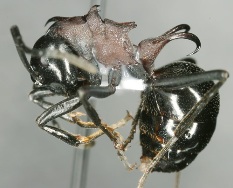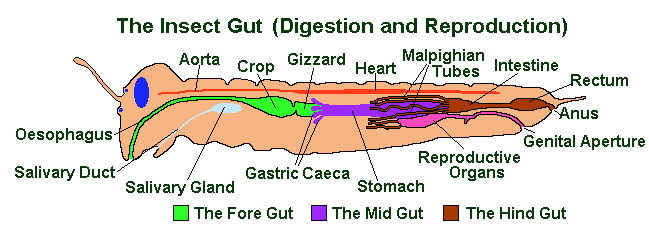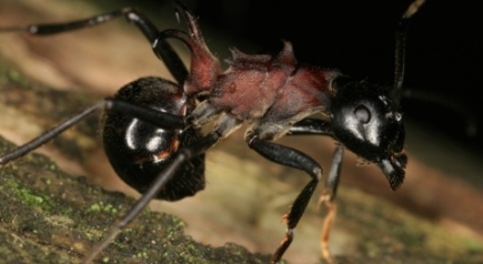Nutrition:
How does it
acquire
its food?
 The Polyrhachis
lamellidens is an omnivore, which means that
it consumes both plants and animals. The
ant first uses the olfactory receptors on the
antennae to locate any possible food sources.
Once the ant has located its food it will use
its specialized mouth parts to clamp on to the
organism. The mandibles of the ant act in
a similar way as the human mouth, but instead of
chewing their food ants use their mandibles to
squeeze their prey. The ant is able to swallow
any of the
juice that arises with the help of the hypopharynx,
which
acts much like a human tongue.
The Polyrhachis
lamellidens is an omnivore, which means that
it consumes both plants and animals. The
ant first uses the olfactory receptors on the
antennae to locate any possible food sources.
Once the ant has located its food it will use
its specialized mouth parts to clamp on to the
organism. The mandibles of the ant act in
a similar way as the human mouth, but instead of
chewing their food ants use their mandibles to
squeeze their prey. The ant is able to swallow
any of the
juice that arises with the help of the hypopharynx,
which
acts much like a human tongue.
Does it have to
overcome cold temperatures?
The Polyrhachis
lamellidens has to survive cold temperatures
during the winter without the luxary of flying
to a warmer climate like the
monarch
butterfly.
The Polyrhachis lamellidens is cold
blooded so its body is unable to heat itself on
its own. This means that the survival of
these ants is dependent on the production of a
very important chemical known as glycerol.
This chemical acts as an “anti-freeze” and
allows the ants to make it through the winter
without freezing to death. The
Polyrhachis lamellidens also hibernate in their nests to help survive the
winter. When both glycerol production and
hibernation are used in harmony with one
another, these ants are more than capable of
surviving a brutally cold winter.
Does it serve as a
host for other organisms?
The Polyrhachis
lamellidens and the bacterial mutualist
Blochmannia are endosymbiotants of one
another. These symbiotants are obligate
mutualists, which means that both organisms must
have a symbiotic relationship with one another
in order to survive. The bacteria live in
specailized cells in the ant called
bacteriocytes. The Blochmannia are
bennefitted by living in the ant, because they
are given a home where they can survive and
reproduce. The bacteria are vital to the
Polyrhachis lamellidens survival,
because they synthesize important nutrients
that the ants need to survive.
endosymbiotants of one
another. These symbiotants are obligate
mutualists, which means that both organisms must
have a symbiotic relationship with one another
in order to survive. The bacteria live in
specailized cells in the ant called
bacteriocytes. The Blochmannia are
bennefitted by living in the ant, because they
are given a home where they can survive and
reproduce. The bacteria are vital to the
Polyrhachis lamellidens survival,
because they synthesize important nutrients
that the ants need to survive.
What does it eat?

How does it
transport ingested food and water?
The digestive system
is made up of a long straight tube that runs
from the mouth to the anus. The tube is
broken up into three sections called the fore
gut, mid gut, and hind guy. Each section
possesses different organs and performs
different functions involved with digestion.
The digestive process begins when the mandibles squeeze the juices from the food and
the nutrients
travel down the fore gut. The fore gut
most simply acts as an esophagus until it
reaches an organ called the crop. The crop
is one of the two stomachs that this ant
possesses (more on this further down page).
The mid gut of the ant possesses the second
stomach, which is used solely for food storage.
The nutrients then move to the hind gut where
the intestines and rectum break down the food.
The digested material is then expelled through the
anus.
Does it have a
circulatory system?
It possesses and open
circulatory system, which is significantly
different from the closed circulatory system
that is seen in humans. In a closed
circulatory system the
 blood is always
circulated in vessels, but in an open system the hemolymph (insect version of blood) spends much
of its time flowing freely within the body
cavities of the ant. The major structural
component of its circulatory system is called a
dorsal vessel. This structure collects hemolymph and it is conducted foreword with the
help of the tubular heart. After the
hemolymph “bathes” the organs, it percolates
back through the body until it re-enters the
tubular heart structure.
blood is always
circulated in vessels, but in an open system the hemolymph (insect version of blood) spends much
of its time flowing freely within the body
cavities of the ant. The major structural
component of its circulatory system is called a
dorsal vessel. This structure collects hemolymph and it is conducted foreword with the
help of the tubular heart. After the
hemolymph “bathes” the organs, it percolates
back through the body until it re-enters the
tubular heart structure.
(This image cannot be found online)
How does it store
its food?
When ants take in
their food it enters one of two stomachs for
storage. The first stomach is called the
crop, and it is used as a “social stomach.”
Ants will regurgitate the contents of this
stomach as a way to feed other members of their
colony. The second stomach is located in
the mid gut region, and it is used solely as a
food storage center for that organism.
Click here to continue on to the Reproduction page.
Click here to go back to the home page.